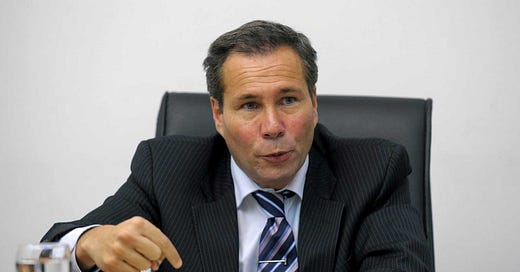Federal Prosecutor Alberto Nisman
Eight years since the murder of a kirchnerista who rebelled.
First, he wasn't a lone soldier of justice, fighting the good fight against a corrupt system from its margins. Until the last two years of his life (perhaps somewhat before, it’s hard to be sure) he was a key player in the system that eventually turned on and killed him.
He managed to come out of the AMIA 1 trial with his reputation unscathed despite being a key player in the prosecution team, quite a feat. Néstor Kirchner had a political problem when that trial produced no convictions. Nisman looked like a good way of solving it. What better way to calm the public than to put a Jewish lawyer in charge of the investigation into a massacre almost all of the victims of which were Jews? Who could object to that? Nisman was Néstor’s man, hard though that might be for kirchneristas to swallow today.
With the benefit of hindsight, we can perceive the bargain on which his appointment was based: he could investigate the Iranians to his heart’s content but there must be no poking of sticks into local wasps’ nests. While Néstor lived all went swimmingly, international arrest warrants for the Iranian organizers of the massacre were obtained and at the annual UNGA Néstor called on the Iranians to extradite them. All the while Nisman enjoyed the benefits of being a high-level public servant. Zipping around town with armed guards (including, as we now know, some from the state intelligence service) must have been great for his never-small ego, to say nothing of extensive foreign travel and being feted in capital cities by people with their own furrows to plough.
Things started to change even before Néstor’s death when in June 2010 the phlegmatic Foreign Minister Jorge Taiana resigned, no longer able to stomach the repeated public humiliations dished out to him by Cristina Fernández de Kirchner, who had succeeded her husband in office. Taiana was replaced by Héctor Timerman, who as a young newspaper editor had enthusiastically supported the 1976-83 dictatorship until it devoured his father.
Right from the start of his period in office he began to emit signs of discomfort with the extradition requests for the Argentine fugitives. When Néstor died in October 2010 the last effective brake on Cristina Fernández’s garbled, conspiracist worldview was removed. We don’t know exactly when but efforts to reach out to Iran started soon afterwards and led to the signing of the infamous Memorandum of Understanding with the Teheran regime in 2013. Its central and quite lysergic idea was that the Argentine judge and prosecutor (i.e Nisman) investigating the AMIA massacre would be allowed to interview the suspects in Teheran. The Memorandum was immediately challenged in the courts and eventually declared unconstitutional.
That would have been a good moment for Nisman to resign as it was now public and obvious that the government of Argentina was bent on full reconciliation with the Iran regime and wanted to brush the AMIA massacre permanently under the carpet.
But he hung on in office; the mistake of a man who was confident the wiretaps he was listening to of the back channel negotiations with Iran would give him the means of turning the tables on Fernández by charging her and her associates with conspiring with the Iranians to protect the organizers of the AMIA massacre. From having been a successful operator within the system of power in Argentina Nisman had now effectively gone rogue. He seems to have believed that he alone (perhaps with a little help from deposed state intelligence strongman Stiuso) could pull down the temple For reasons we don’t yet know and may never do, in Jan 2015 he decided to suddenly fly back from a holiday in Europe to lodge a criminal complaint against Fernández and several of her associates. Four days later he was dead, murdered with the assistance of his erstwhile friend and collaborator Diego Lagomarsino, and of his bodyguards. He lodged the complaint and then sat at home waiting for them to come for him, a mistake he’d never have made before years of coddling by the state and the spoils of high office had dulled his reflexes. Overall though, not a failed life, quite the contrary. Though in the end he lost, he played for the highest stakes.
From relatively modest beginnings to a key post in the federal legal structure, and a seat on the federal bench for his then-wife too. That might have been part of the quid pro quo with Néstor. And he didn’t flinch from the essential point and its possible consequences for his safety; the AMIA massacre was organized and executed by Iran. Had he pursued their local facilitators with more energy it might not have been possible to be as clear about this. Since he died a chorus of hangers-on abroad has taken to identifying themselves as his friends. Best ignore them, he was not the gregarious type anyway and the “My friend Alberto Nisman” brigade is just using his name to further their political objectives, objectives which have little to do with what Nisman’s story and what it’s about: power in Argentina, how it’s accumulated and exercised, and the place of Jews in Argentine society.
On this anniversary as with every previous one, the progressive and state media gleefully blackens his name: he had an undeclared bank account abroad (totally unheard of in Argentina) and he dated attractive young women (something comfortably off and recently divorced men in their 50s never do) are two favoured attack lines. The energy still being poured into this, and the claim that he committed suicide are evidence of the troubled conscience of kirchnerismo, the hollowness of its human rights discourse and the special cheapness of Jewish lives in Argentina.




